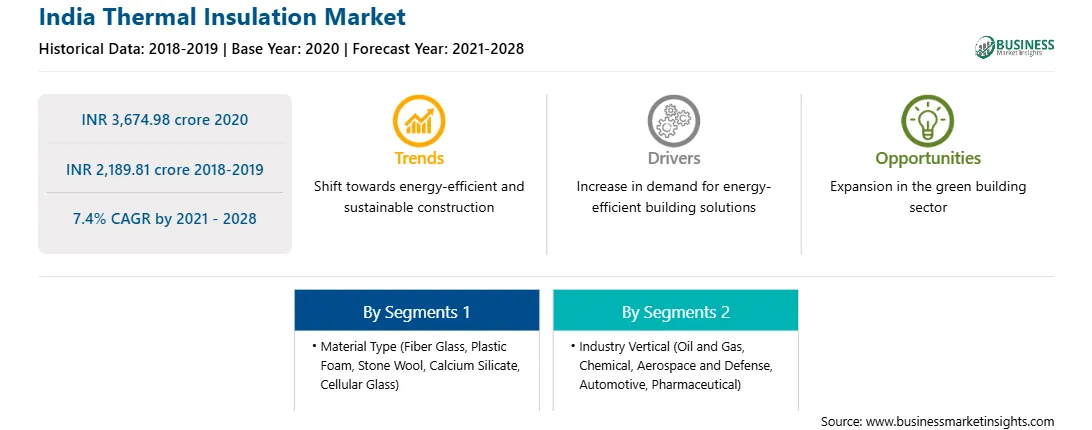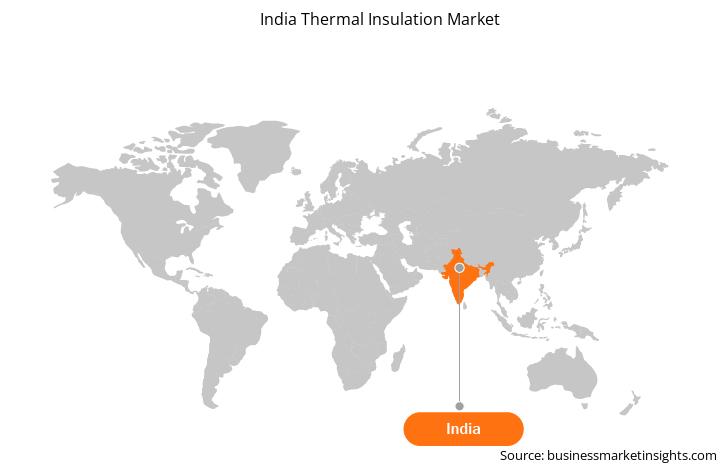Market Introduction
Rising investments in the construction industry coupled with widening scope of the industry in India drive the India thermal insulation market. Also, growth in residential and constitutional buildings are expected to offer lucrative growth opportunities to the market in the coming years. The government of India is focused on enhancing the country's electrification rate coupled with technological advancements, which would propel the demand of thermal insulation during the forecast period. Moreover, the thermal insulation is used for high efficiency in the varying temperature of the industries. Further, the growing pharmaceutical industry in India is offering significant business opportunities for the thermal insulation market players to increase their respective customer base and expand their presence across the country.
Further, since the first quarter of 2020, India imposed lockdown restrictions to control the spread of novel coronavirus that causes COVID-19. These restrictions restricted the movement of materials and people and disrupted the supply chain in the thermal insulation industry. Moreover, amid COVID-19 pandemic, new construction activities in India are put on hold due to the lockdown. Therefore, the demand for thermal insulation is decreased.
Strategic insights for the India Thermal Insulation provides data-driven analysis of the industry landscape, including current trends, key players, and regional nuances. These insights offer actionable recommendations, enabling readers to differentiate themselves from competitors by identifying untapped segments or developing unique value propositions. Leveraging data analytics, these insights help industry players anticipate the market shifts, whether investors, manufacturers, or other stakeholders. A future-oriented perspective is essential, helping stakeholders anticipate market shifts and position themselves for long-term success in this dynamic region. Ultimately, effective strategic insights empower readers to make informed decisions that drive profitability and achieve their business objectives within the market. The geographic scope of the India Thermal Insulation refers to the specific areas in which a business operates and competes. Understanding local distinctions, such as diverse consumer preferences (e.g., demand for specific plug types or battery backup durations), varying economic conditions, and regulatory environments, is crucial for tailoring strategies to specific markets. Businesses can expand their reach by identifying underserved areas or adapting their offerings to meet local demands. A clear market focus allows for more effective resource allocation, targeted marketing campaigns, and better positioning against local competitors, ultimately driving growth in those targeted areas.India Thermal Insulation Strategic Insights

India Thermal Insulation Report Scope
Report Attribute
Details
Market size in 2020
INR 3,674.98 crore
Market Size by 2028
INR 2,189.81 crore
CAGR (2021 - 2028) 7.4%
Historical Data
2018-2019
Forecast period
2021-2028
Segments Covered
By Material Type
By Industry Vertical
Regions and Countries Covered
India
Market leaders and key company profiles
India Thermal Insulation Regional Insights

Market Overview and Dynamics
The India thermal insulation market was valued at INR 3,674.98 crore in 2020 and is projected to reach INR 2,189.81 crore by 2028; it is expected to grow at a CAGR of 7.4% from 2021 to 2028. The rising expansion and evolution of India’s infrastructural stock is playing a critical role against climate change. According to Observer Research Foundation (ORF) online organization, the country’s total energy consumption accounts for more than 40% of the energy consumed by buildings, which is increasing with rate of 8% annually. The practice of conventional inefficient building continues, and the buildings are anticipated to account for around 70% of emissions by 2050, thus posing a major threat to India’s green ambitions. As per the International Finance Corporation (IFC), about 70% of the infrastructural development that includes construction of buildings are required to be completed in India by 2030. The government of India is focusing on embracing the concept of green buildings to meet this huge demand and precisely deal with the environment and economy. At present, the green buildings market in India is currently at a growing stage, with only 5% buildings being classified as green buildings. Some of the initiatives, such as the 2008 National Action Plan for Climate Change and National Commission on Enhanced Energy Efficiency, are being taken by the Indian government to boost the construction of green buildings across the country.
The constant rise in the infrastructural development in India is expected to boost the residential sector and industrial activities, which, in turn, would increase the adoption of insulation material during the forecast period. The Indian government is focused on introducing various infrastructure projects, such as the urban transformation schemes, smart city initiative, business parks, and new industrial estates, which are projected to boost the adoption of thermal insulation material during the forecast period. According to the India Brand Equity Foundation (IBEF), India is expected to become the third largest construction sector in the world in the coming years. Several initiatives, such as “Smart City Mission” and “Housing for all”, across the country are boosting the adoption of thermal insulation. The growing infrastructural investment with the increasing FDI in the country drive the growth of the thermal insulation market in India. Such initiative along with rising infrastructural spending in India is creating huge opportunity for the Indian market players to develop advanced material for thermal insulation.
In India, to reduce the energy consumption in buildings, the government announced the Energy Conservation Building Code (ECBC) in the year 2007, which is applicable for commercial buildings that has a connection load of about 100 kW or 120kVA. It helps in saving around 25%–40% of energy, compared to reference buildings without such energy efficiency measures. As per the ECBC, the provisions for installation of renewable energy generation systems are made mandatory. Any complaints of the buildings are registered with the updated buildings code and are ready for the installation of renewable energy systems. The proportion of total electricity demand is met through renewable energy systems rising with the efficiency level the project across the country. The significant objective of this initiative is to encourage the building design with the strategies to follow the norm for buildings in India. The building energy codes relate to the climate responsive buildings, which are used with local natural resources and climatic conditions.
Key Market Segments
The India thermal insulation market is segmented on the basis of material type and industry vertical. Based on material type, the market is segmented into fiber glass, plastic foam, stone wool, calcium silicate, cellular glass, and others. In terms of industry vertical, the India thermal insulation market is segmented into oil and gas, chemical, aerospace and defense, automotive, pharmaceutical, and others.
Major Sources and Companies Listed
The top companies operating in the field of access control are Armacell India Pvt. Ltd., BASF SE, Imerys, Lloyd Insulations (India) Limited, Minwool Rock Fibres Limited, Neo Thermal Insulation (India) Pvt. Ltd., Owens Corning, Saint-Gobain, Supreme Petrochem Ltd, Thermocareindia, and ROCKWOOL INDIA PVT. LTD .Various other companies operating in the market are coming up with new technologies and offerings, which is bolstering the growth of the India thermal insulation market.
Reasons to buy report
INDIA THERMAL INSULATION MARKET SEGMENTATION
India
Thermal Insulation
Market – by Material Type
India Thermal Insulation Market – by
Industry Vertical
India Thermal Insulation Market - Companies Mentioned
The List Companies - India Thermal Insulation Market
The India Thermal Insulation Market is valued at INR 3,674.98 crore in 2020, it is projected to reach INR 2,189.81 crore by 2028.
As per our report India Thermal Insulation Market, the market size is valued at INR 3,674.98 crore in 2020, projecting it to reach INR 2,189.81 crore by 2028. This translates to a CAGR of approximately 7.4% during the forecast period.
The India Thermal Insulation Market report typically cover these key segments-
The historic period, base year, and forecast period can vary slightly depending on the specific market research report. However, for the India Thermal Insulation Market report:
The India Thermal Insulation Market is populated by several key players, each contributing to its growth and innovation. Some of the major players include:
The India Thermal Insulation Market report is valuable for diverse stakeholders, including:
Essentially, anyone involved in or considering involvement in the India Thermal Insulation Market value chain can benefit from the information contained in a comprehensive market report.